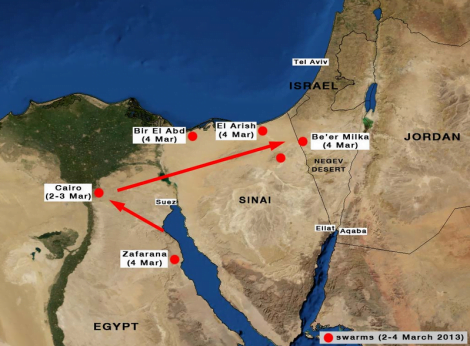Locusts are descending on Israel.
That map comes via the UN’s Food and Agriculture Organization’s Locust Watch, which writes:
Remnants of several small immature Desert Locust swarms that appeared in Cairo, Egypt on 2 March were seen the following day near the international airport on the eastern edge of the city. Several small immature swarms moved to the northern Sinai Peninsula where they were seen on the northern coast near Bir El Abd and El Arish on 4 March. On the same day, locals reported seeing locusts south of El Arish near Jebel Halal, and at least one small swarm crossed the nearby border into the northern Negev Desert of Israel where it was seen in the Nitzana area near Be’er Milka. Control operations were undertaken immediately in both countries, and no damage to crops was reported.
Locust teams in both countries are checking all areas for any further infestations. There is a risk that a few more locusts from the Sinai will arrive in the Negev today on northwesterly winds, and some could reach adjacent areas of the Aqaba Valley in Jordan. From tomorrow onwards, the possibility of additional locust groups and small swarms moving into Israel and Jordan will decline considerably as the winds shift and come from the north and northeast.
Those of us in the west may view this map with some bemusement, but desert locusts are a serious problem in the Middle East, North Africa and even sub-saharan Africa. Most of countries affected by locusts are not terribly resilient to this kind of disruption of food supply and livelihood, so even a moderate swarm could cause big damage.
Thankfully, the FAO is available to mitigate some of this problem though a fairly well-developed system of Locust monitoring and control.
They can severely damage crops in countries that are not terribly resilient. The most recent plague occurred in 2004 and caused over $2.4 billion in damage.
This outbreak will not become a plague, but it is still serious enough to warrant international attention. Thankfully, the

